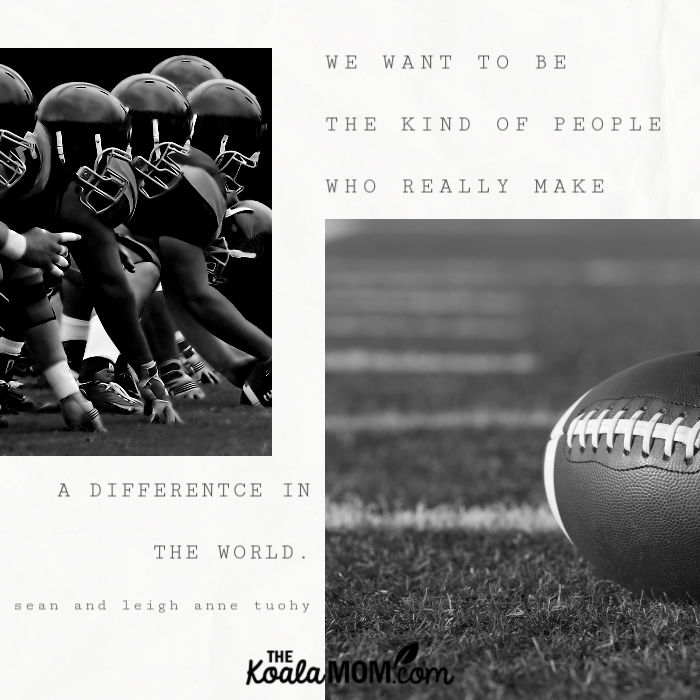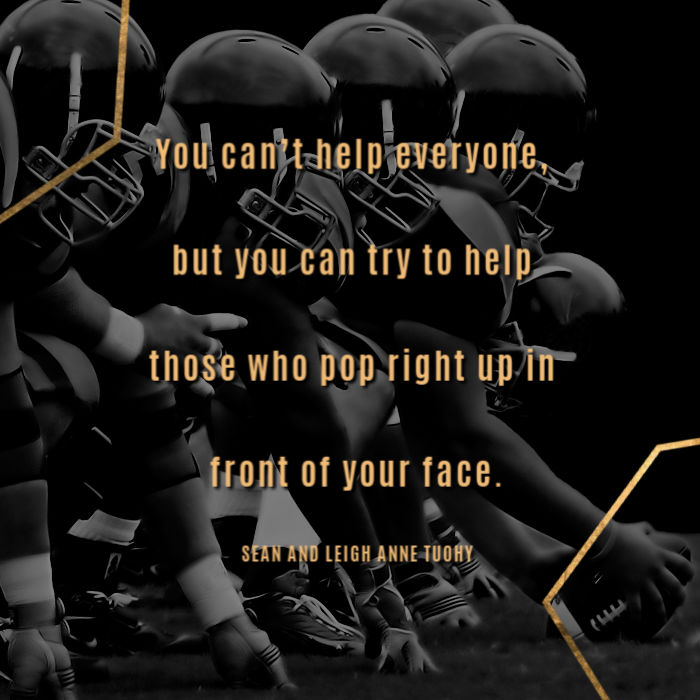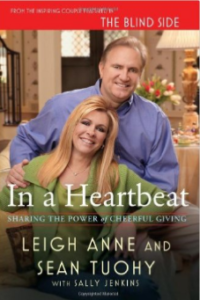My husband and I watched The Blind Side, a true story about a football player and his adoptive family, and really enjoyed it. So when I saw that the couple whose story inspired that movie had written a book, I couldn’t wait to read it. Check out my review of In a Heartbeat: Sharing the Power of Cheerful Giving by Sean and Leigh Anne Tuohy. Here’s a taste of what Sean and Leigh Anne have to say (and what you won’t see in the movie!).
Interview questions provided by the B&B Media Group. This post contains affiliate links; as an Amazon associate, I earn from qualifying purchases.
 TKM: Besides dominating the New York Times bestseller list, The Blind Side
TKM: Besides dominating the New York Times bestseller list, The Blind Side  has also broken Hollywood records. Why do you think your family’s story has captivated so many people?
has also broken Hollywood records. Why do you think your family’s story has captivated so many people?
Sean and Leigh Anne Tuohy: We think people love the story because they recognize some aspect of themselves there. We want to be the kind of people who really make a difference in the world, but so many people are convinced they don’t have the resources to be that kind of giver.
We wrote In a Heartbeat to share our story in our own words precisely so that people will begin to realize that they can be the kind of people who help change someone’s life.
TKM: Let’s talk about the problem of homeless and needy children in America. How do you believe this problem can be solved?
Sean and Leigh Anne Tuohy: There are a lot of intractable problems in the U.S., from terrorism to health care. But the problem of children in need is curable; we can all do something about it today, individually, through the smallest acts.
If every church in the U.S. sponsored one child, we could wipe out the problem of homeless children in this country. There are a million Michaels. Not every kid has the potential to become a star player in the NFL, but he or she may be the person who grows up to cure cancer, or become a great husband or wife to someone.

TKM: How do you respond when people marvel at the risks you took as you brought Michael Oher into your family?
Sean and Leigh Anne Tuohy: You know, you take a risk every day of your life. When you get in your car and drive across a bridge you take a risk. You don’t know if your tires are good, or if the pilings are going to hold, or if the bridge will fall in. But you don’t really stop and think about it, do you? You don’t get up every morning and kick all four of your tires. You don’t stare at the bridge and say, ‘Yeah, I think it’ll hold me.’ How did you know that bridge wasn’t going to fall? Yet you went right ahead and crossed it.
Everybody takes risks, every day. You just don’t realize that’s what you’re doing.
More about adoption:
TKM: How do you define “cheerful giving”?
Sean and Leigh Anne Tuohy: This is not giving to impress someone who may be watching, and it’s not giving because you feel guilty. The Bible says it best:
“Each man should give what he has decided in his heart to give, not reluctantly or under compulsion, for God loves a cheerful giver.”~ 2 Corinthians 9:7
TKM: In your book, you sum up your philosophy of giving in “The Popcorn Theory.” Tell us more about that.
Sean and Leigh Anne Tuohy: The Popcorn Theory is about noticing others. It’s about seeing, not turning away from the immediacy of someone in need. It starts with recognizing a fellow soul by the roadside—even if he doesn’t seem to belong in your lovely red brick neighborhood and he is the biggest damn piece of popcorn you ever saw and his problems seem too immense to take on.
It’s about assigning that person value, and potential. Like popcorn, you don’t know which kernel’s gonna pop. They just show up. It’s not hard to spot ‘em.
The Popcorn Theory goes like this: “You can’t help everyone, but you can try to help the hot ones who pop right up in front of your face.”
TKM: What if I don’t have many resources? How can I be a cheerful giver without a bunch of extra money?
Sean and Leigh Anne Tuohy: Too often we think we lack the means to improve someone’s lot. We’re wrong.
The Popcorn Theory doesn’t require you to write a large-scale check, or to take a hungry boy with eyes like leaping flames into your household. But it does require that you perceive the person standing right in front of you, and extend a hand in kindness.
Consider this story we heard from a U.S. Senator during a trip to Washington for an Adoption Coalition convention:
There is a little-known Congressional initiative to give internships to young people who were so unwanted they have aged out of the foster care system. This Senator employs one such young man. One day the Senator passed by the mailroom, and paused and turned around. He noticed that his intern, fresh out of foster care, had reorganized all the old files.
“This room has never looked so clean,” the Senator said. “You did a great job.”
A few minutes later the Senator decided to get a cup of coffee. He returned to mailroom and found that his intern had tears streaming down his face. “Son, did I offend you?” he asked.
“No,” the young man said. “That’s the first time anyone has ever told me that I did something good.”
This gift had nothing to do with money. What this kid needed most was encouragement and self-worth, and that’s what he was given.

TKM: As you share your story, one of the points you stress is that generosity is not just your personal value. It’s a core value for the entire family. What specific things have you done as parents to help your kids become cheerful givers?
Sean and Leigh Anne Tuohy: One of our practices is something we call “Get one, give one,” which means when you receive something, give part of it away. To impress the lesson on our daughter Collins, we sent her to camp with underprivileged kids and on a searing mission trip to the Guatemala City Dumps. She saw families living in lean-tos amid the garbage, yet with pictures of Christ hung amid the wreckage.
Collins came to understand how fortunate she was: “He has shown kindness by giving you rain from heaven and crops in their seasons; he provides you with plenty of food and fills your hearts with joy” (Acts 14:17). She also learned how important it was to share some of what she’d been given.
Long before Michael came into our lives, Collins and Sean Jr. learned to accept the presence of kids sleeping on the sofa or lounging around the house. Friends at the Briarcrest School whose parents worked two jobs.
One afternoon 7-year-old Sean Jr. came home to find them playing with his X-box. He sought out Leigh Anne and said, “What gives?” She replied, “We’re just helping them out. Be generous.” Sean Jr. went back downstairs and watched the brothers play a video game. “I’ve got the winner,” he said.
TKM: In the book, you point out that the most important gifts your children gave each other had nothing to do with money. Tell us about those gifts.
Sean and Leigh Anne Tuohy: As Michael became a member of the family, he and our other kids gave each other two small but crucial mutual gifts—loyalty and protection. At Ole Miss, Collins and Michael went everywhere together, and they and their friends achieved a new level of racial integration at that old southern school.
Even now, when our family attends Michael’s games, he remains extremely protective of his sister, insisting on one occasion that his teammate walk her to the car to keep her away from unruly male fans. And for Sean Jr., having Michael in his family means they do more as a family—he gets much more of each of them.
This is one of the blessings of cheerful giving. We have always felt that Michael gave us far more than he received. All we did was put a roof over his head. He has given us back a stronger sense of home and family.
Have you seen The Blind Side or read In a Heartbeat? How does Sean and Leigh Anne Tuohy’s story inspire you?


No Responses Yet